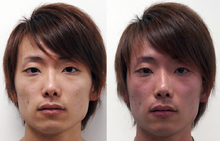| Alcohol intolerance | |
|---|---|
| Other names | Acute alcohol sensitivity |
 | |
| Skin flushing, a common symptom of alcohol intolerance | |
Alcohol intolerance is due to a genetic polymorphism of the aldehyde dehydrogenase enzyme, which is responsible for the metabolism of acetaldehyde (produced from the metabolism of alcohol by alcohol dehydrogenase).[1][2] This polymorphism is most often reported in patients of East Asian descent.[3][4][5][6] Alcohol intolerance may also be an associated side effect of certain drugs such as disulfiram, metronidazole, or nilutamide. Skin flushing and nasal congestion are the most common symptoms of intolerance after alcohol ingestion.[5][6] It may also be characterized as intolerance causing hangover symptoms similar to the "disulfiram-like reaction" of aldehyde dehydrogenase deficiency or chronic fatigue syndrome.[7][8][9] Severe pain after drinking alcohol may indicate a more serious underlying condition.[5][10]
Drinking alcohol in addition to consuming calcium cyanamide can cause permanent or long-lasting intolerance (nitrolime disease),[11][12] contributing (in conjunction with other substances) to the accumulation of harmful acetaldehyde in the body by inhibiting the acetaldehyde dehydrogenase enzyme.
- ^ Agarwal, Dharam P.; Goedde, H. Werner (1990). Alcohol Metabolism, Alcohol Intolerance, and Alcoholism. pp. 57–59. doi:10.1007/978-3-642-74904-9. ISBN 978-3-642-74906-3. S2CID 46280438.
- ^ Harada, S.; Agarwal, D.P.; Goedde, H.W. (October 1981). "Aldehyde Dehydrogenase Deficiency as Cause of Facial Flushing Reaction to Alcohol in Japanese". The Lancet. 318 (8253): 982. doi:10.1016/s0140-6736(81)91172-7. ISSN 0140-6736. PMID 6117742. S2CID 6468178.
- ^ Mizuno, Yuji; Morita, Sumio; Harada, Eisaku; Shono, Makoto; Morikawa, Yoshinobu; Murohara, Toyoaki; Yasue, Hirofumi (2013). "Alcohol Flushing and Positive Ethanol Patch Test in Patients with Coronary Spastic Angina: Possible Role of Aldehyde Dehydrogenase 2 Polymorphisms". Internal Medicine. 52 (23): 2593–2598. doi:10.2169/internalmedicine.52.0894. ISSN 0918-2918. PMID 24292747.
- ^ Tsuritani, Ikiko; Ikai, Eriko; Date, Takayasu; Suzuki, Yasuhito; Ishizaki, Masao; Yamada, Yuichi (1995). "Polymorphism in ALDH2-genotype in Japanese men and the alcohol-blood pressure relationship*". American Journal of Hypertension. 8 (11): 1053–1059. doi:10.1016/0895-7061(95)00222-b. ISSN 0895-7061. PMID 8554727.
- ^ a b c "Alcohol intolerance - Symptoms and causes". Mayo Clinic. Retrieved 2019-11-07.
- ^ a b Aoki, Y.; Wehage, S. L.; Talalay, P. (November 2017). "Quantification of skin erythema response to topical alcohol in alcohol-intolerant East Asians". Skin Research and Technology. 23 (4): 593–596. doi:10.1111/srt.12376. PMID 28513003. S2CID 34497300.
- ^ De Sousa, Avinash (2019). Disulfiram: Its Use in Alcohol Dependence and Other Disorders (1st ed.). Singapore: Springer Singapore. pp. 9–10. ISBN 978-981-32-9876-7.
- ^ Petersen, E. N. (November 1992). "The pharmacology and toxicology of disulfiram and its metabolites". Acta Psychiatrica Scandinavica. 86 (S369): 7–13. doi:10.1111/j.1600-0447.1992.tb03309.x. ISSN 0001-690X. PMID 1471556. S2CID 21475637.
- ^ Hald, Jens; Jacobsen, Erik (2009-03-13). "The Formation of Acetaldehyde in the Organism after Ingestion of Antabuse (Tetraethylthiuramdisulphide) and Alcohol". Acta Pharmacologica et Toxicologica. 4 (3–4): 305–310. doi:10.1111/j.1600-0773.1948.tb03352.x. ISSN 0001-6683.
- ^ Ma, Lucy; Varma, Sanskriti; Niranjan-Azadi, Ashwini (2019). "Hodgkin lymphoma presenting as alcohol-induced back pain". BMJ Case Reports. 12 (11): e228440. doi:10.1136/bcr-2018-228440. ISSN 1757-790X. PMC 6887434. PMID 31780609.
- ^ Potential risks to human health and the environment from the use of calcium cyanamide as fertiliser, page 29, Scientific Committee on Health and Environmental Risks, Retrieved 14 November 2016
- ^ Deutsche Forschungsgemeinschaft DFG, ed. (2012-10-17). List of MAK and BAT Values 2012: Maximum Concentrations and Biological Tolerance Values at the Workplace. Report 48. Weinheim, Germany: Wiley-VCH Verlag GmbH & Co. KGaA. doi:10.1002/9783527666034. ISBN 978-3-527-66603-4.